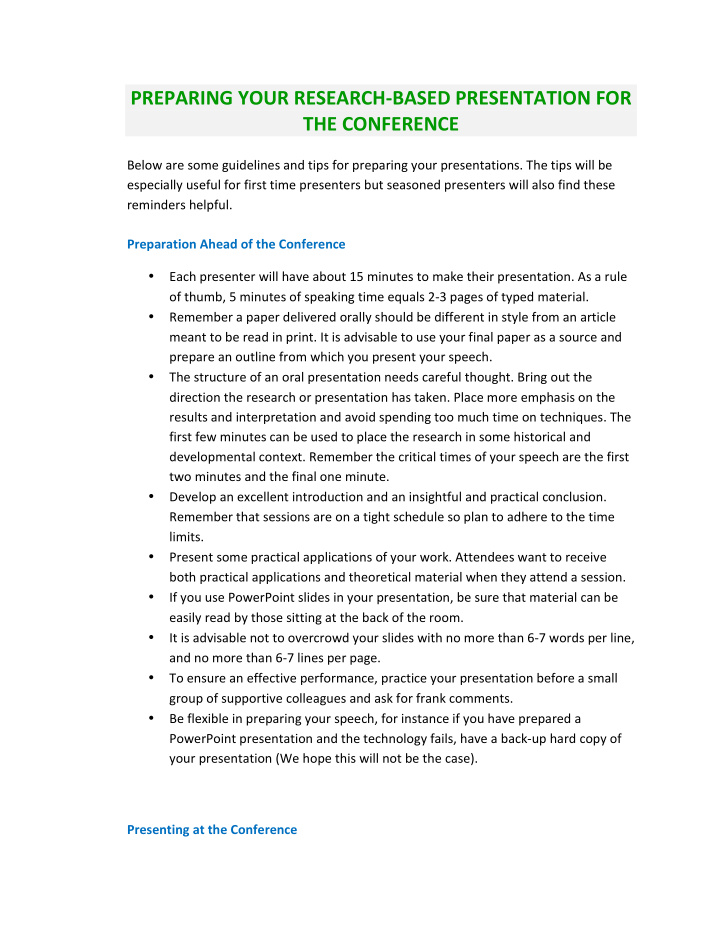



¡ PREPARING ¡YOUR ¡RESEARCH-‑BASED ¡PRESENTATION ¡FOR ¡ THE ¡CONFERENCE ¡ ¡ Below ¡are ¡some ¡guidelines ¡and ¡tips ¡for ¡preparing ¡your ¡presentations. ¡The ¡tips ¡will ¡be ¡ especially ¡useful ¡for ¡first ¡time ¡presenters ¡but ¡seasoned ¡presenters ¡will ¡also ¡find ¡these ¡ reminders ¡helpful. ¡ ¡ Preparation ¡Ahead ¡of ¡the ¡Conference ¡ • Each ¡presenter ¡will ¡have ¡about ¡15 ¡minutes ¡to ¡make ¡their ¡presentation. ¡As ¡a ¡rule ¡ of ¡thumb, ¡5 ¡minutes ¡of ¡speaking ¡time ¡equals ¡2-‑3 ¡pages ¡of ¡typed ¡material. ¡ • Remember ¡a ¡paper ¡delivered ¡orally ¡should ¡be ¡different ¡in ¡style ¡from ¡an ¡article ¡ meant ¡to ¡be ¡read ¡in ¡print. ¡It ¡is ¡advisable ¡to ¡use ¡your ¡final ¡paper ¡as ¡a ¡source ¡and ¡ prepare ¡an ¡outline ¡from ¡which ¡you ¡present ¡your ¡speech. ¡ ¡ • The ¡structure ¡of ¡an ¡oral ¡presentation ¡needs ¡careful ¡thought. ¡Bring ¡out ¡the ¡ direction ¡the ¡research ¡or ¡presentation ¡has ¡taken. ¡Place ¡more ¡emphasis ¡on ¡the ¡ results ¡and ¡interpretation ¡and ¡avoid ¡spending ¡too ¡much ¡time ¡on ¡techniques. ¡The ¡ first ¡few ¡minutes ¡can ¡be ¡used ¡to ¡place ¡the ¡research ¡in ¡some ¡historical ¡and ¡ developmental ¡context. ¡Remember ¡the ¡critical ¡times ¡of ¡your ¡speech ¡are ¡the ¡first ¡ two ¡minutes ¡and ¡the ¡final ¡one ¡minute. ¡ • Develop ¡an ¡excellent ¡introduction ¡and ¡an ¡insightful ¡and ¡practical ¡conclusion. ¡ Remember ¡that ¡sessions ¡are ¡on ¡a ¡tight ¡schedule ¡so ¡plan ¡to ¡adhere ¡to ¡the ¡time ¡ limits. ¡ • Present ¡some ¡practical ¡applications ¡of ¡your ¡work. ¡Attendees ¡want ¡to ¡receive ¡ both ¡practical ¡applications ¡and ¡theoretical ¡material ¡when ¡they ¡attend ¡a ¡session. ¡ • If ¡you ¡use ¡PowerPoint ¡slides ¡in ¡your ¡presentation, ¡be ¡sure ¡that ¡material ¡can ¡be ¡ easily ¡read ¡by ¡those ¡sitting ¡at ¡the ¡back ¡of ¡the ¡room. ¡ ¡ • It ¡is ¡advisable ¡not ¡to ¡overcrowd ¡your ¡slides ¡with ¡no ¡more ¡than ¡6-‑7 ¡words ¡per ¡line, ¡ and ¡no ¡more ¡than ¡6-‑7 ¡lines ¡per ¡page. ¡ ¡ • To ¡ensure ¡an ¡effective ¡performance, ¡practice ¡your ¡presentation ¡before ¡a ¡small ¡ group ¡of ¡supportive ¡colleagues ¡and ¡ask ¡for ¡frank ¡comments. ¡ • Be ¡flexible ¡in ¡preparing ¡your ¡speech, ¡for ¡instance ¡if ¡you ¡have ¡prepared ¡a ¡ PowerPoint ¡presentation ¡and ¡the ¡technology ¡fails, ¡have ¡a ¡back-‑up ¡hard ¡copy ¡of ¡ your ¡presentation ¡(We ¡hope ¡this ¡will ¡not ¡be ¡the ¡case). ¡ ¡ ¡ ¡ Presenting ¡at ¡the ¡Conference ¡
2 ¡ ¡ • Arrive ¡a ¡few ¡minutes ¡early ¡to ¡meet ¡with ¡the ¡session ¡chair ¡and ¡other ¡presenters. ¡ Make ¡sure ¡your ¡presentation ¡has ¡been ¡uploaded ¡and ¡that ¡any ¡audio-‑visual ¡ equipment ¡you ¡are ¡using ¡is ¡working. ¡ • When ¡speaking ¡assume ¡the ¡possibility ¡of ¡hiccups ¡e.g. ¡technology ¡breakdown, ¡so ¡ be ¡flexible ¡in ¡preparing ¡your ¡presentation. ¡ ¡ • Stay ¡within ¡the ¡allotted ¡time ¡limit ¡when ¡making ¡your ¡presentation. ¡ • Stop ¡on ¡time. ¡Remember ¡there ¡are ¡other ¡speakers ¡during ¡this ¡time ¡slot, ¡so ¡be ¡ considerate ¡of ¡their ¡time. ¡ • As ¡you ¡speak, ¡establish ¡eye ¡contact ¡with ¡the ¡audience; ¡vary ¡your ¡styles ¡of ¡ presentation. ¡Don't ¡read ¡handouts ¡verbatim ¡when ¡talking. ¡Simply ¡refer ¡to ¡them, ¡ but ¡allow ¡participants ¡to ¡be ¡actually ¡involved ¡in ¡developing ¡the ¡outcome. ¡ • Be ¡enthusiastic ¡as ¡you ¡present ¡as ¡your ¡presentation ¡will ¡leave ¡a ¡first ¡impression ¡ of ¡your ¡work. ¡If ¡it ¡is ¡positive, ¡then ¡their ¡overall ¡impression ¡of ¡you ¡and ¡your ¡work ¡ is ¡reinforced. ¡ • Enjoy ¡yourself ¡as ¡you ¡present ¡your ¡paper! ¡ ¡ Tips ¡for ¡Preparing ¡Your ¡Power ¡Point ¡Presentation ¡ ¡ 1. Use ¡PowerPoint ¡to ¡prepare ¡your ¡presentation, ¡other ¡software ¡formats ¡(e.g. ¡Prezi ¡ may ¡be ¡used ¡as ¡well). ¡ 2. Each ¡presenter ¡has ¡about ¡15 ¡minutes, ¡so ¡consider ¡using ¡15 ¡slides ¡or ¡less ¡ 3. The ¡first ¡slide ¡should ¡include: ¡Presentation ¡title, ¡author ¡names, ¡institution ¡etc ¡ 4. The ¡middle ¡slides ¡should ¡try ¡to ¡cover ¡the ¡following ¡elements ¡of ¡your ¡study ¡or ¡ work: ¡ ¡ o Introduction/Background ¡ o Objectives ¡or ¡purpose(s) ¡of ¡the ¡study/practice ¡ o Perspective ¡or ¡theoretical/conceptual ¡framework ¡ o Methods ¡& ¡data ¡sources ¡ o Results/Findings/Outcomes ¡ o Implications ¡ § Implications ¡for ¡practice: ¡How ¡can ¡the ¡findings ¡help ¡others ¡(e.g., ¡ practitioners, ¡educators, ¡policy ¡makers)? ¡ ¡ § Implications ¡for ¡research: ¡Based ¡on ¡the ¡results ¡and/or ¡limitations ¡ of ¡this ¡study, ¡what ¡should ¡future ¡studies ¡in ¡this ¡area ¡do? ¡ o Discussion ¡ ¡ RESEARCH ¡& ¡DEVELOPMENT ¡ ¡ ¡
3 ¡ ¡ § I dentify ¡the ¡most ¡interesting ¡findings ¡and ¡provide ¡an ¡ explanation/rationale. ¡ § Why ¡did ¡this ¡study ¡get ¡the ¡results? ¡Is ¡it ¡similar ¡to ¡past ¡research? ¡ Can ¡theory ¡explain ¡the ¡findings? ¡Is ¡there ¡something ¡about ¡this ¡ data ¡collection ¡that ¡made ¡the ¡results ¡different? ¡ o Key ¡references ¡ o Acknowledgments ¡(as ¡applicable) ¡ ¡ Consent ¡ By ¡submitting ¡an ¡abstract ¡and ¡presentation ¡to ¡this ¡conference, ¡you ¡are ¡giving ¡permission ¡ for ¡your ¡abstract ¡& ¡presentation ¡to ¡be ¡made ¡available ¡on ¡the ¡internet ¡and ¡accessible ¡to ¡ the ¡general ¡public. ¡ ¡ ¡ For ¡queries ¡about ¡this ¡document ¡send ¡an ¡email ¡to ¡submissions@avu.org ¡ ¡ ¡ RESEARCH ¡& ¡DEVELOPMENT ¡ ¡ ¡
Recommend
More recommend